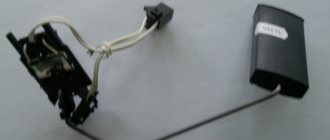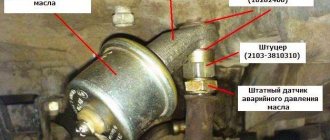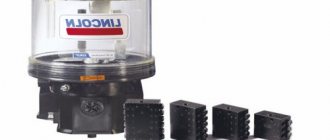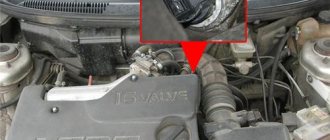A restyled version of the famous VAZ nine, the VAZ 2114, appeared in mass production in 2003. At first, an eight-valve one and a half liter VAZ-2111 engine was installed on it, then there was a 1.6-liter VAZ-11183, and in 2010 they began installing a VAZ 21126 engine with a power of 98 hp. With. All these power units have in common the fact that they are fuel injected.
What is a throttle position sensor, its operating principle, design?
The operation of the throttle valve is oriented towards regulating the air pressure in the intake system. Based on the principle of operation of the valve, while the damper is open, the pressure in the system is comparable to atmospheric pressure, after closing, a vacuum is formed in the system.
The throttle position sensor is installed in the power system on the throttle axis and regulates its speed. If we consider the design of the sensor, we can say that it is a potentiometer that controls voltage changes. The device is resistive and contains an active slider; has three outputs: voltage supply, ground and motor control.
While the throttle valve is in the closed position, the sensor voltage is minimal. The voltage increases in proportion to the opening of the damper, and in the extreme position reaches about 5V. The engine control unit, based on the received sensor data, is able to assess the movements of the throttle valve and, if necessary, changes the nature of its operation, subsequently changing the timing and amount of the fuel-air mixture, ignition.
In some cases, instead of a potentiometer, a magnetic-resistive sensor is installed, which consists of a static magnet (placed on the damper shaft), an element with electronic sensitivity made of magnetoresistive material. It is considered non-contact because there is no mechanical connection. The operation of the contactless sensor is based on magnetic waves when the damper axis is rotated with a change in resistance.
Flushing the throttle valve
In this article we will describe two types of throttle valve cleaning:
- Surface.
- Full.
These two types differ in the degree of difficulty of cleaning and, accordingly, in quality.
Superficial cleaning
The essence of this cleaning is that we will not completely disassemble the entire throttle assembly, but will go over the valve with a cloth and remove surface dirt.
For work we will need:
- Any cleaning agent: carburetor cleaner, alcohol, thinner, gasoline, wd-40. They differ only in the degree of “removability” of dirt and that’s all.
- Rag.
- Brush.
First of all, we remove the air filter bell from the throttle valve, take our cleaning agent and spray it inside the throttle valve. We begin to clean the surface with a rag and brush. Also, do not forget to open the damper itself and clean it from the back side. This completes our process; we reinstall the air filter pipe and that’s it. But with this cleaning method, we will not be able to completely clean all the insides of the throttle valve, we will not be able to blow through all the holes and channels, so it is better to use a complete cleaning.
Complete throttle body cleaning
To completely clean the damper, in addition to a rag and cleaning agent, we will need:
- Flathead, Phillips screwdriver.
- Throttle valve gasket (for 1.5L) and receiver O-ring (for 1.6L) (approximate cost 20-50 rubles).
- Cotton buds.
- Socket wrench set to "13".
- 2 M13 bolts.
In this case, we need to completely remove the throttle assembly and clean it from all sides.
- In order to remove the unit, disconnect the air filter corrugation and remove the ohm pipes. liquid (in the Murzilka it is recommended to drain the liquid before starting work, but do not waste time on this by removing the pipes from the throttle - just plug them with bolts so that the liquid does not spill out), remove the adsorber pipe.
- Disconnect the throttle assembly mount, remove the throttle cable, and remove the throttle assembly. If you require a more detailed description of removing the throttle assembly, then read the article: How to remove the throttle assembly, valve?
- Having removed the throttle valve, we disconnect and clean the IAC sensors (how to clean IAC), TPS and completely wash the damper on all sides with a cleaner, be sure to blow out all the holes with compressed air.
- Then we install everything back, not forgetting to put in a new gasket.
Types of remote control position sensors
Today, the automotive industry presents two types of sensors:
- Contact potentiometer. Used by all vehicle manufacturers. The design has a slider and resistive tracks. It is rigidly mounted on the throttle pipe and connected to the axle. It works based on voltage dynamics, which contributes to the correction of the fuel supply ECU. When pressure is applied to the accelerator, the throttle opens, which turns the axis and moves the slider, changing the length of the resistive tracks of the electrical circuit.
- Contactless. Produced as an alternative potentiometer. It works based on dynamic changes in the influence of the magnetic field. The slider does not contact the working part because it has a permanent magnet. The electronic element reacts to changes. It is believed that such sensors are more durable and less likely to break. However, it is worth considering that they cost an order of magnitude higher.
It is believed that magnetoresistive sensors are more durable and less likely to break. However, it is worth considering that they cost an order of magnitude higher.
Causes of malfunctions
Reasons why repair or replacement of the TPS may be required:
- The contact elements have become acidic. This problem can hardly be called a breakdown, but it refers to malfunctions that can be eliminated. During prolonged use, the sensor contacts may oxidize. This is due to the operation of the TPS under conditions of temperature changes and exposure to moisture. To eliminate the problem, you need to dismantle the controller and clean the contact elements with cotton wool treated with WD-40.
- Erasing the coating based on the initial segment of the slider movement. If the resistive base is removed, the controller will not operate correctly. As the slider moves, the voltage supplied to the control module will increase. But as a result of erasing, this does not happen, since there is no resistance. This leads to problems, and sometimes the control module malfunctions.
- Damage to the tips on the device. If this happens, burrs will form on the lining, which will ultimately lead to failure of the remaining elements. In some cases, the contacts will continue to function, but this will not last long, especially since the wear on the substrate will increase. With such problems, the slider and the resistive layer will refuse to contact, which will lead to the inoperability of the machine’s motor.
- Slider failure. This component of the device wears out over long-term use. As a result, it may deviate from the required trajectory, which will lead to problems.
One of the reasons for the failure of the throttle position controller is shown in the video of the “Everything Yourself” channel.
Types of TPS faults
Problems with the operation of the throttle sensor are associated with its design design, and are generally characteristic of most variable resistors. Car enthusiasts identify three main problems:
- Wear of the moving contact or film resistance.
- Backlash of fastenings.
- Oxidation of active contacts.
During the operation of the moving contact and interaction with the film resistance, constant friction arises, which, with prolonged exposure, wears out both the resistive layer and the surface of the active contact itself. Practice shows that the degree of wear directly depends on driving style and manifests itself extremely unevenly. Because of this, only in some places places are formed where the active contact does not reach the resistive layer, causing the voltage to disappear at the output of the throttle position sensor.
In this case, in older fuel-injected vehicles, fuel delivery is reduced and the risk of engine detonation increases. In modern fuel-injected internal combustion engines, the system blocks the operation of the power unit and activates the “check engine” indicator.
Oxidation of working contacts occurs exclusively under conditions of high humidity under the hood. As a result, the resistance may increase and the electrical contact may be completely broken.
Possible faults
The contact-type sensor is quite reliable, and according to the designers’ plans, it should last at least 50,000 km. This is ideal under average operating conditions. In practice, it often fails before reaching half of its intended lifespan. Like any mechanics, the controller is very demanding regarding various clearances, frequency and speed of movement of the slider. The situation is complicated by the difficulty of diagnosis. The main symptoms of a malfunction of the VAZ-2110 throttle sensor are very similar to damage to many other components of the car. However, symptoms of TSD damage may include the following:
- deterioration of engine dynamic characteristics;
- jerking during intense acceleration;
- stopping the engine when changing gears;
- “dips” when sharply pressing the gas pedal.
As already noted, the weak point of the TPS is the mechanical moving contact. The resistor slider, moving across the resistive layer, damages it. The thin coating simply rubs off, the contact deteriorates, making further operation of the car problematic. In addition, the moving contact itself may break. In this case, the engine almost does not respond to the gas pedal.
In any case, the TPS cannot be repaired, and there is no point in restoring it. The price of the sensor does not exceed 300 rubles. True, first of all, you need to make sure that it is he who is faulty.
Causes and signs of sensor failure
You can determine the malfunction of the throttle sensor by several “symptoms”:
- Decrease in total vehicle power;
- Increased fuel consumption;
- Late response after pressing the gas pedal;
- Unstable idle speed;
- Acceleration is accompanied by sharp jerks.
Similar signs can be observed when some other elements of the engine compartment break down, so before starting measures to correct the problem, it is necessary to check the operation of the TPS. In general, there are several reasons for throttle sensor failures:
- Deformation of the base coating at the beginning of the active slider operation, due to which the output voltage cannot increase linearly;
- Core failure. Breakage of at least one tip provokes the formation of burrs and nicks on the base of the substrate, which leads to failure of the remaining tips. As a result, contact disappears completely.
Dips of the car when operating in 1st–3rd gears may indicate incorrect adaptation of the throttle valve or a poor-quality sensor. Non-original devices are very temperature dependent. Then, the more the housing is heated, the more often the output changes.
HOW TO CHECK ITS WORK INDEPENDENTLY
You already know the signs of a malfunctioning throttle position sensor, let's try to check its functionality ourselves. A sequenced test cycle will help you check how to check the throttle position sensor. To perform this, you need to have a tester, a multimeter or a simple voltmeter with a scale of 15-20 volts.
The verification procedure will be as follows:
- You need to open the hood and find the TPS. Look for it near the throttle valve;
- To check, a connector from this sensor is required, so it is disconnected from the TPS;
- Now a voltmeter or other devices are connected to work in voltage measurement mode. The “minus” of the device is connected to the “ground” of the car, and the voltage will be checked with the second probe. Carefully examine the connector body and find the terminal marked with the letter “A”.
- With the ignition on, check for voltage at this terminal. It should be equal to 5 volts. If there is power, then the TPS is out of order and must be repaired or replaced. If the voltage is significantly lower than 5 volts or is absent at all, it is necessary to check the entire electrical circuit of its power supply. If everything is fine with it, the controller may fail.
You can check the operation without disconnecting the connector from the TPS. Let's look at this technique in action, how to check the TPS without disconnecting it from the power supply. The purpose of the test remains the same, this is to check the presence of supply voltage at the TPS. With the ignition on and a voltmeter connected, the device should show a smooth voltage change from 0.7 to 4 V if you smoothly turn the plastic throttle sector. The TPS connector must be connected, and the supply voltage is checked by calcining the wire with the probe of the measuring device.
Article on the topic: Replacement and repair of VAZ 2110 starter
If you have an ohmmeter, you can check the resistance of the sensor potentiometer. In this case, the connector is disconnected from the TPS, and the ohmmeter probes must be connected to any fixed and moving contacts. When the sector rotates, the meter needle should move smoothly. Jerking or jerking movement of the instrument needle is evidence of its malfunction.
It makes no sense to repair it, since the reasons for the malfunction of the VAZ 2114 TPS almost always lie in the breakage of the conductive layer. Easier to replace with a new one.
Manufacturers guarantee its normal operation for approximately 50 thousand kilometers. Currently, TPS from the city of Kaluga have appeared. They are a contactless device that does not have a moving slide, and the contact does not wear out. The service life of such a device is unlimited.
When the TPS on a car is being replaced, this is a favorable moment to repair the throttle valve. Repair will be said loudly, since in most cases everything is limited to cleaning and washing this unit.
Use any liquid to clean carburetors, do not miss a single channel when cleaning and everything will work out.
Sometimes the question arises about how to test a new throttle position sensor. This can be done using an ohmometer as described above.
Diagnostics of TPS operation
You can diagnose the operation of the sensor and throttle on your own. To do this, it is necessary to create easy access to the device under the hood (by and large, it is enough to remove the filter air ducts from the pipe and remove the ventilation hoses).
After this, you need to disconnect the contact wires of the throttle position sensor, exposing the three main contacts (be sure to understand which contact is responsible for what). Next, start the engine and connect the positive terminal of the multimeter to power, and the negative terminal to ground. After turning on the tester and taking measurements, the indicator should vary from 4 to 6 Volts.
After turning off the ignition, measurements are carried out by switching the multimeter to measure resistance. Tests are carried out with the throttle closed in order to obtain reliable data on the resistance between ground and signals to the ECU. Data of 0.8–1.2 kOhm are considered normal. A similar test must be repeated with the throttle open (data norm 2.3–2.7 kOhm).
If the data obtained differs from the diagnostic norm, you can safely conclude that there is a malfunction and the need to replace the sensor. Some cars have their own performance standards. You can get acquainted with it on the official website of the manufacturer, on forums or in the technical manual of the vehicle.
The procedure for removing and installing TPS on a VAZ 2114
As usual, it's worth first providing a detailed report in the video review.
Video on replacing the throttle position sensor on a VAZ 2114
The process is shown along with instructions for replacing the IAC, as the procedures are very similar.
And below, in standard form, is a photo report of the work done.
First, you need to disconnect the “-” terminal from the battery to de-energize the car. After this, you need to find our sensor on the throttle assembly and disconnect the plug from it, after first squeezing the plastic lock:
The end result is shown in the photo below.
After this, you need to unscrew the two screws using a Phillips screwdriver.
And now you can remove the sensor, since nothing else holds it. This should be done carefully, perhaps slightly turning the TPS housing so that it can be removed without problems.
Before installation, be sure to check the integrity of the foam gasket, as well as the markings when purchasing a new sensor. It should be the same as on the old part.
Installation is carried out in the reverse order and will not pose any problems.
The price of a new TPS for a VAZ 2114 is about 350-500 rubles, depending on the manufacturer of this spare part.
The VAZ throttle position sensor (TPS) is part of the engine throttle assembly. Therefore, when checking the TPS, check the IAC (see the article How to check the IAC (Idling Air Sensor)?, because in certain situations they have similar symptoms of a malfunction. Signs of a malfunction of the TPS and IAC:
It is worth noting that this sensor is not available on new samara-2 models due to the use of an electronic gas pedal.
To check the throttle position sensor, we will need the following tools: a multimeter (ohmmeter, voltmeter), pieces of wire.
Conclusion: If the sensor is faulty, then there are two options to solve the problem:
Replacing the throttle position sensor and adjusting the new device
In most cases, replacing the sensor is quite simple and you can do it yourself. The whole procedure consists of three main parts: dismantling the old faulty device, installing a new TPS, resetting the error from the ECU memory. In some cases, you will need to adjust the new device.
Actions must be carried out with the ignition off and the sensor de-energized. Unscrew the two fastening screws and remove the connector from the device. Hurray, the old sensor has been removed.
To install a new sensor, you must carefully connect the end of the throttle axis to the device seat. The holes must be aligned while turning the device in a circle. Next, you need to screw in the mounting screws and secure the connector.
To correctly reset the error from the ECU controller, you must leave the terminals disconnected from the battery for at least 8 hours. Within approximately this period, the controller's memory should be reset to zero. The most reliable option, if the first method does not help, is to contact a service center, where the problem will be corrected using a motor tester. On the other hand, you can risk continuing to use the vehicle in a “gentle mode”, hoping that sooner or later the ECU will reset the error on its own.
Adjusting the TPS or how to adjust the damper position sensor with your own hands
After installing a new TPS on Lanos, it is necessary to adjust the device. Setting (also called calibration) is needed to ensure the correct functioning of the element. The adjustment features are based on the following steps:
- First, we check the element and make sure that it needs adjustment. To do this, we measure the voltage at the sensor contacts. The value should be 0.7V with the damper closed. If this is not the case, then the TPS needs adjustment
- To do this, loosen the fastening screws and turn it clockwise. If there is no free play when loosening the screws, then you need to increase the diameters of the sensor holes. This can be done with a file or a drill bit.
- Having enlarged the mounting hole, you need to reinstall the element in place and measure the voltage with the ignition on. The value should be 0.65-0.7V
- Having set the appropriate voltage value, it is recommended to reset the ECU by removing the negative terminal for 15-20 minutes
- After connecting the terminal, you need to turn on the ignition for 15 seconds and then turn it off
- The ignition is turned on again and the engine starts
Now you understand what adjusting the TPS on Lanos is, and why you need to perform this procedure. After installing a contactless throttle sensor, you can notice improvements in your car such as improved engine responsiveness when you press the gas pedal, the disappearance of twitching and jerking in 1st and 3rd gear, reduced fuel consumption, etc. Reviews show that it is better to overpay and buy a contactless damper position sensor than to replace contact devices every 2-3 years.
Procedure for replacing TPS
If, if there is a malfunction of the throttle position sensor on a VAZ 2114, you nevertheless decide to replace it, then you need to study the procedure and also know the correct adjustment after replacement.
In order to remove the old device, simply unscrew the two screws that secure it to the throttle system. Now, the sensor can be safely removed from the damper axis. When installing a new part, carefully ensure that the connection sockets are directed towards the partition of the engine compartment. After this, align the mounting ears with the holes on the body, and screw both screws into place.
The next step is to adjust the TPS. It is done as follows: the throttle valve must be moved to the open position. If this cannot be done, it means that the sensor is installed incorrectly. In this case, it needs to be rotated 90 degrees and re-secured.
Once the device is configured, connect all the wires to it. Before starting the engine for the first time, be sure to remove the terminals from the battery for about 10 minutes. If after the work done, the engine runs stably, then there is no longer a malfunction. If the signs persist, then you should contact a car service center to diagnose the electrical equipment.
The VAZ 2114 throttle sensor is necessary for the proper functioning of the fuel system. An injector is not only a ramp with nozzles, but also a set of sensors and actuators that are responsible for the normal functioning of all systems. Let’s talk about one of the units, consider the features of repair and replacement, as well as typical breakdowns. As the name suggests, this sensor is installed on the throttle valve, on its axis. It is based on a change in resistance, in other words, TPS is nothing more than a variable resistor (but there are also contactless devices).
What should I do if I have problems with idle speed after adjusting the sensor?
If adjusting the throttle position sensor led to jumps in idle speed, you need to perform a procedure to familiarize the electronic unit with the characteristics of the new TPS.
The task is performed like this:
- The terminals from the battery are disconnected. The clamps are loosened with a wrench, after which you need to wait about 20 minutes.
- Then the terminals are connected back. Before the next step, you need to make sure that the valve of the unit is closed.
- The key is inserted into the lock and the ignition is activated for approximately 15 seconds. The power unit does not start. After this, the ignition is turned off.
- Then you need to wait about 20 more seconds. During this time, the microprocessor module will be able to remember the characteristics of the new TPS in its memory.











